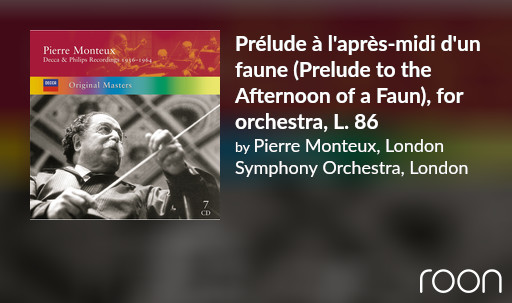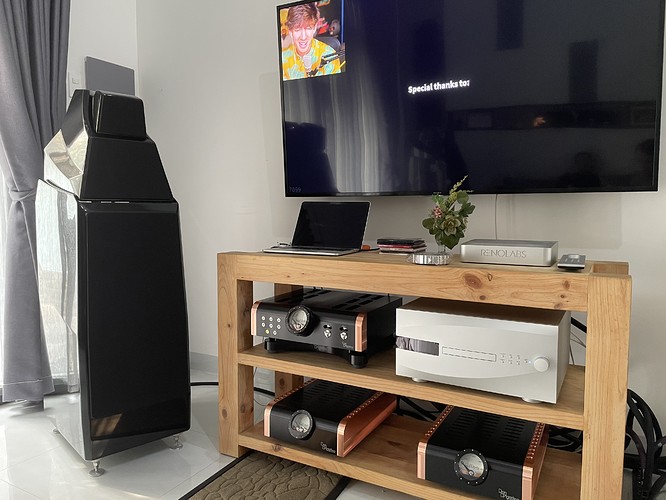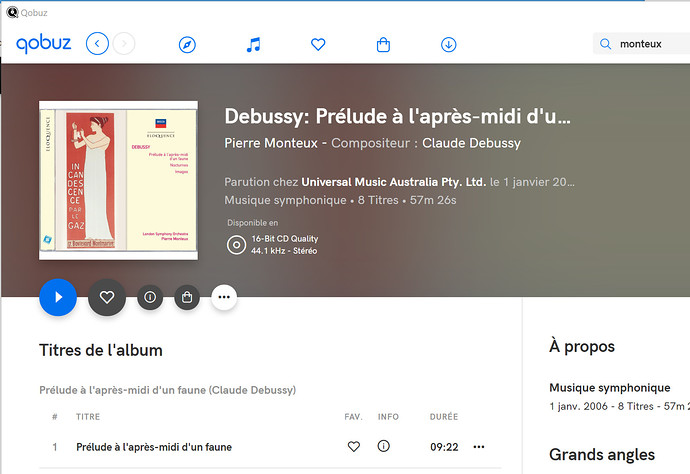Interesting. DCS seem to suggest Upsampler gives bigger improvement but personal experience of others differs. I imagine it depends on system and personal preferences. Given I need to buy a NB or Upsampler it seems like a waste to buy a NB now if I later go for an Upsampler anyway. I suppose the answer is buy a clock as well! And there was me originally thinking the Bartok price was insane.
Dear Gas,
I heard Rossini dac and Vavaldi One in my system recently. In my opinion, the Rossini dac is bolder than Vivaldi. I mean that Vivaldi One is faster and brighter than Rossini dac. I think Rossini dac is a very good dac and resonable price.
Very nice stereo, it must sound very good.
Very interesting Doctor. I agree the Rossini is fantastic. Haven’t heard the Vivaldi One. But it’s interesting that you say it is brighter. I am currently trying to demo an Upsampler with my Vivaldi dac (vs Network Bridge). Various problems getting 4 identical AES cables so I’m still struggling to come to firm conclusions but I might agree that the Upsampler is “brighter” than the bridge. It is definitely different. Sometimes. Depends on track. So I wonder if the brighter you noticed is down to the upsampling rather than the dac. I wouldn’t say the dac is bright although it does reveal highs very well.
The other effect of the UPS is a kind of “spatial” effect. Almost like the kind of stereo effects you can switch on in car stereos. I’m not saying it is that but it is a change to the sound stage. Music also sounds clearer to me often. BUT a couple of times listening to a vocalist I’ve got the feeling that more emotion is conveyed through the NB than the UPS. Maybe even more body to the voice although less spatial sound stage and not as “clear” through NB. I wonder if there is something going on like sharpening of digital images? Small amount of sharpening is usually an improvement. Too much and it looks weird. Or maybe the UPS is revealing more background information which is confusing my perception of the vocal. Or it’s just different to what I’m used to and I need to acclimatise to a new better.
Anyway I can see why you’d think the Upsampler is brighter. Maybe you should try the Vivaldi dac without Upsampler. ![]()
I think that there is some confusion here as to exactly what is being compared to what. Well, I’m confused anyway ![]() .
.
However there is no Vivaldi Upsampler per se involved on the comparison. It has been a comparison of Vivaldi One with Rossini. Both are all-in-one-box machines. You cannot switch off the upsampling in Rossini or Vivaldi One ( one can only select between DXD and DSD upsampling, there is no Clone mode) so a comparison of the two in regard to the effect of upsampling or not is impossible.
Hi,
Interesting, I have a NB and a Vivaldi Dac…Do you have the Vivaldi Clock ? If you have it, what did it bring to the sound according to you ? If you don’t have it, why did you choose to replace the NB rather than getting the Vivaldi Clock ?
I know the feeling. ![]() What are your current thoughts on Upsampling Pete?
What are your current thoughts on Upsampling Pete?
I don’t have a clock. I was told by a knowledgeable industry person that the Upsampler was easily a bigger improvement over the clock. So am demoing that. Still confused.
Dear Gas,
Before I try dCS, I have been Chord Dave and Blu II for over one year. I connected Blu II to Dave with Odin 2 bnc. (Blu2 can do upsampling to 768hz). With this setup, music have very good sound stage but thinner than Dave alone and music didnot have body as Dave alone. I love Dave alone setup.
Now Rossini dac and Vivaldi One, I have the same feeling. I think the Vivaldi One is more suitable for the big speaker or big cable as Transparent Cable. With Rossini dac I would love a small speaker and or small cable as Nordost.
With Vivaldi One, Momentum, wilson alexia 2, odin 2 interconnect in my curently setup, everything is thin. I’m thinking about Transparent cable. I love some body in the voice, instrument etc.
They remain pretty much as always. I do not, however, simply rely upon a judgement which may have been formed a long time ago although various changes may have occurred since. So I revisit upsampling regularly including immediately before writing this.
Since I last wrote substantively on the subject I have replaced virtually all of my cable loom. This has had a profound and beneficial effect generally but I am still concerned with exactly the same odd, or even contradictory, effects upon positions within the soundstage when I engage any upsampling. As I think I have said before, these would be of little concern with recordings having either no discernable or artificially created soundstages. So that really confines the issue to classical music recordings in practice.
I posted a list of recordings where I had found issues for people to explore and make up their own minds a year or two back but there was no subsequent response.
After reading your post I revisited one where I found the oddities most pronounced (Debussy: L’apres midi d’une faune/Monteux/LSO . A great classic recording engineered by Kenneth Wilkinson and recorded in the superb acoustics of Walthamstow Town Hall ( Decca Australian Eclipse). I am not going to reveal what I hear now as I want people to find out for themselves.
Listening to Andy McHarg during the Qobuz dCS interview am am sure that he may argue that upsampling per se cannot be the cause of what I hear. ( and he will probably be right). However I cannot disbelieve my ears ![]() .
.
Do you experience the upsampling problem with Bartok, Rossini or other makes?
Phill
I have no idea as I can only afford to own one dCS range at a time ![]() . However it is not possible to make upsampling v. no upsampling comparisons with Bartok or Rossini as upsampling cannot be defeated.
. However it is not possible to make upsampling v. no upsampling comparisons with Bartok or Rossini as upsampling cannot be defeated.
I also have possessed only dCS digital processors since the end of the last century so cannot comment on products from other manufacturers.
I can say that I ( and others) have heard this problem with the dCS Elgar or “Classic” 4 box range, the Paganini 4 box and ultimately with Vivaldi.
Is it to do with the flute at the start?![]() What I hear there isn’t so much sound stage though. Struggling a bit with sound stage comparisons as I’m not familiar with the recording so can’t identify oddities easily. Can you reveal the time of the events?
What I hear there isn’t so much sound stage though. Struggling a bit with sound stage comparisons as I’m not familiar with the recording so can’t identify oddities easily. Can you reveal the time of the events?
And is there a prize if I get it right?
This non-upsampling DAC.
Yes, you have got it when you say that “there isn’t so much soundstage”. Unfortunately with a Bartok you cannot try it without upsampling when you should find that , being a Kenneth Wilkinson engineered recording ( Google him if you are unaware of his reputation) , it should and can produce one of the most convincing three dimensional soundstages with the orchestra layered front to back , woodwind behind strings, horns behind the woodwind as you would hear an orchestra in real life. However with upsampling engaged the orchestra becomes a single plane of sound, in my case located a few inches behind the speakers. I also find one of those aural equivalents of a visual illusion whereby the oboe solo a few bars from the beginning is both part of that single plane of sound but also seems to come from a point behind the plane simultaneously - a bit like that illusion with a cube where it can be seen as both pointing towards you and receding from you.
The solo flute at the beginning should be heard as being within the large space of the hall where you should get some idea of its boundaries rather than just hearing flute and generalised reverberation.
Of course were this type of thing limited to a single recording it could just be written off as an oddity but once spotted …
Not quite sure which recording you mean here. I found this one on Decca Australian Eloquence, which is recorded at Kingsway Hall, not Walthamstow Town Hall. Is there another one?

That’s the one I found. Which looks the same as yours. Non MQA version.
Maybe this observation is common to upsampling?
Great. I’ll have another listen. Unfortunately I’m very prone to hearing what I think I’m going to hear so will probably hear that now but believe it is just my imagination.
Yes Rudi, that is the one that I was using. The original recording dates from 1961 so there have been numerous reissues ever since especially as this is regarded as having historic importance. GAS_sufferer appears to have found another version of it. Of course I cannot guarantee that the two reissues sound identical but I hope that the essential characteristics have been retained.
Thanks for the correction on the recording venue. Sadly they had to stop recording at KIngsway Hall once digital came along as the extended bass response meant that a long standing problem with the Central Line tube trains running beneath became intractable. I have actually attended a ( analogue) Decca session there and from time to time recording had to stop to let the train pass. Not only did the producer have a score but also a train timetable!
Yes, as mentioned to @Jacobacci there have been different reissues over the years and that looks like the same recording. There can be differences between different issues of course so I will try to find your one on Qobuz and check it .
Meantime I found my notes from my earlier posting on this issue which cited two other examples of recordings to listen to to check the difference between upsampled and native resolution. They were these if you want to see if you can hear any oddities even if you cannot make that exact comparison:
Beethoven Op.126 Bagatelles , Alfred Brendel. Philips 1990 cycle. 16/44.1. CD rip.
Bologna 1666, Kammerorchester Basel, Julia Schroder. DHM, 24/96. Purchased download.
I cite the original of my copies but both are available via Qobuz if you have that resource.
It seems to be the same recording but different low pass filters. The one you find through Roon (the one I linked to) has less hiss due to a lower low pass filter it seems. The one that Rudi linked to doesn’t seem to appear in Roon unless you first save it in Qobuz as a favourite.
Anyway I listened to Rudi’s version, comparing NB to UPS with no upsampling first. Disappointingly the UPS did have much more open soundstage, more transparent and did not become mushy in the busy sections as the NB did. Thank you for that. That track really made clear what the differences are which I was struggling to really comprehend. Now I see it everywhere else as well. Can I charge the cost of an Upsampler to you Pete?
Regarding the upsampling affecting the soundstage I’m still not sure. Sometimes I thought I could hear the flatter depth and other times not. I wonder if dsdx2 is better than dxd for that. Need to spend some more time comparing. Or money on the rest of the system.
So do you never Upsample Pete?
Only for these tests. I use the Vivaldi UPS only for its superior implementation of the network interface. I abandoned upsampling as having any beneficial impact over a decade ago. Yes it may have been positive in its effect during the earlier years of digital reproduction when many nostrums for improving the subjective sound of CD were popular such as painting the edge of the disc in green or using stabiliser mats. Since then digital reproduction has improved significantly leaving the reason to upsample questionable IMO. I am basically asserting that it degrades rather than improves.
I did check the version you found of the Monteux track via Qobuz v. my rip of the Decca Eloquence CD. Ascloseasthis but ultimately not identical. Hardly surprising .

